
The recent detection of HPAI at Crescent Duck Farm has thrust bird flu concerns back to the forefront. The risk to humans remains low, but those who maintain backyard flocks should be vigilant and take extra precautions to avoid exposing their birds.
“The virus is carried through clothing, shoes, equipment, through infected feces and potentially through the air from the respiratory secretions,” said Kate Perz, 4-H Animal Science Program Coordinator for Cornell Cooperative Extension of Suffolk County. “All it takes is a wild bird defecating and their feces landing on the ground and a bird walking through it, or a person walking through it, and then walking into a feed store, and then someone else walking through that and then entering their poultry coop,” she said.
Although unlikely, experts outlined precautions. “If you do keep bird baths, keeping them clean, if you do have chickens, keeping them separated. There are many precautions you can take that further minimize the chances of an already rare circumstance,” said Jennifer Murray of Turtleback Ecological Center.
Certain types of birds are more likely to be carriers than others, with shore birds, waterfowl, corvids (crows and ravens) and raptors (birds of prey) most at risk. This includes birds that obtain some or all of their nutrition from scavenging. “Anything that eats carrion, like turkey vultures, could be impacted. So anything that would have direct contact with a sick, injured or dead bird that has avian flu,” said Ms. Murray.
Songbirds are not considered a vector for this strain of HPAI at this time, so taking down feeders is not essential. Still, out of an abundance of caution, wear gloves when filling or cleaning feeders to be hygienic. “It’s important to remember that songbirds are not affected as much as the waterfowl. Songbirds are much less likely to contract that avian flu, even if they’re at feeders,” she said. This is because they do not contract this strain easily, and even when they are sick, they do not shed large numbers of the virus, according to All About Birds.
Besides commercial poultry farmers, waterfowl hunters and wildlife rehabilitators need to take the highest precautions because they are directly responding to sick or injured animals.
For backyard chicken owners, the best practice is containment. “[The best thing is] keeping your poultry separated from wild bird populations. If you have a lawn where geese are loafing, you know, because you’re right on the shoreline, or near the golf course or something, obviously keeping your birds contained and away from wild populations is probably safer,” Ms. Murray said.
Following the USDA recommended precautions will go a long way to prevent bird flu spreading to your home flock. To keep from losing all your birds, “try to mitigate [y]our poultry interaction with wild birds. It’s best to keep them in a run instead of free ranging right now. If you have the ability, cover the top of your run to prevent any feces from waterfowl or other birds that are flying over from entering. All it takes is one wild bird defecating into your run, and then that can spread throughout your flock,” Ms. Perz said.
“DEC is working closely with state and federal partners to reduce the spread of HPAI. We encourage the public to report unusual wildlife mortalities to their local DEC regional office. People should avoid direct contact with sick or dead wild birds and poultry, especially waterfowl and raptors. DEC also advises hunters not to harvest sick or dead animals and to wear gloves when processing game,” said New York State Department of Environmental Conservation Interim Commissioner Sean Mahar in a statement from the Suffolk County Department of Health.
The New York State Department of agriculture and markets recommends that pet owners keep their pets away from wild birds and wild bird excrement/other effluence to limit their potential exposure to the virus and, as always, to consult their veterinarian for any specific concerns.
“We want to avoid any kind of panic. A lot of times people see a sick bird, and they automatically think it’s avian flu. But it’s winter, and winter is very hard on survival, especially with the cold snap that we’ve had,” said Ms. Murray. “One seagull on the beach is not going to be of as big a concern to the DEC or other authorities as a mass die off — multiple birds in one concentrated area.”
“Detections are higher in the fall and spring, because wild birds spread the virus as they migrate to their seasonal homes. Animal & Plant Health Inspection Service continues to work closely with state animal health officials on surveillance efforts to look for the virus in commercial, backyard and wild birds. We also continue to encourage all bird owners to practice strong biosecurity—that means reducing opportunities for wildlife to spread the virus to their birds and preventing the spread of the virus from one premises to another,” said a USDA spokesperson.
At the first sign of illness or sudden death, it is crucial to report the incident to authorities. To report sightings of sick or dead birds, call the New York State Department of Agriculture and Markets at 518-457-3502 for domestic poultry, or the New York State Department of Environmental Conservation at 518-478-2203 for wild birds. There is also a web portal for reporting to the DEC.
Ms. Perz emphasized that reporting is essential in order to protect commercial flocks and reduce the economic impact of the outbreak. “This is a reportable disease. We just want to make sure we’re reaching out to the appropriate officials and reporting that so they can come in and help.”

